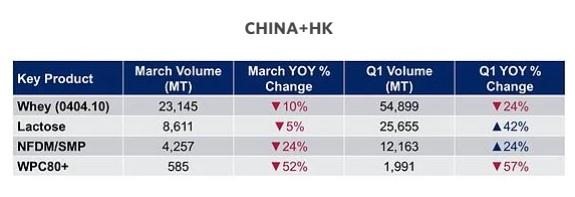U.S. dairy exports in March nearly matched the record high of 2021, as total exports on a milk solids equivalent (MSE) basis decreased by less than 1%, a drop of only 2,005 metric tons (MT) MSE.
The strong performance of cheese (+13%, +4,773 MT), particularly cheddar (+86%, +3,596 MT), is a positive signal to the market, highlighting global consumers’ growing consumption of U.S.-made cheese.
Arguably, a recovery in low-protein whey exports (+1%, +320 MT) after three straight underwhelming months is the most bullish March indicator for future performance. But given the importance of China to the whey market, the country’s recent lockdowns and corresponding fallout regarding supply chains are likely to cause whey exports to fluctuate significantly in the short term.
More broadly, several short-term factors – constrained milk supplies, strong domestic demand early in the year limiting export availability, logistics frustration, and high prices slowing some global demand growth among lower-income consumers – have and continue to act as short-term headwinds to U.S. dairy export volume meeting or exceeding 2021 records.
Export value, on the other hand, continued to soar in March and looks poised to build off the success of 2021 as a result of the tight global market and increased U.S. shipments of higher-value products like cheese, butter and protein concentrates. Export value in March jumped 25% (+$172 million) to $860 million, the highest month on record by a considerable margin.

Below is how U.S. dairy exports fared to the major markets and our key takeaways.
MEXICO

- Key trend: High input costs are reportedly slowing Mexico’s domestic milk production growth, necessitating imports to meet domestic demand.
- Moving forward: Given the tight milk supplies within Mexico, the fact that NFDM volumes still trail pre-pandemic levels on an annualized basis, and logistics headaches are expected to continue, we anticipate greater nonfat volumes moving south of the border this year. Provided the economy holds and inflation is kept to a reasonable level, cheese exports to the country should continue to perform well.
SOUTHEAST ASIA

- Key trend: U.S. exports of high protein whey to the region have slowed down sharply, likely a result of limited availability and high prices burning off some demand. Long-term growth is still very positive, particularly with more supply capacity expected in 2023 and beyond.
- Moving forward: With Southeast Asian markets opening up after two years of relatively tight COVID restrictions, buyers are expected to become increasingly active in anticipation of demand growth. With the recent troubles in China, the U.S. should expect increased competition from New Zealand, as product previously earmarked for China is re-routed to SEA.
CHINA+HK

- Key trend: Government lockdowns continue to snarl global supply chains and limit imports into a market we believed was already well-stocked on ingredients coming into the new year.
- Moving forward: In the short term, we anticipate China’s COVID lockdown measures will challenge exports across the dairy complex. Crucially, if Chinese consumers under quarantine are not consuming fresh milk, not only will that lessen the need for imports, it will also likely result in additional domestic milk production being dried into whole milk powder, further exacerbating the import demand slowdown. The length and severity of the lockdown measures will remain the primary inflection points as to whether this is a short-term blip or will create ripple effects in global dairy markets through the end of the year.
Click here to see more...